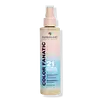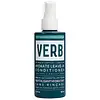What's inside
What's inside
 Key Ingredients
Key Ingredients

 Benefits
Benefits

 Concerns
Concerns

 Ingredients Side-by-side
Ingredients Side-by-side

Water
Skin ConditioningCocos Nucifera Oil
MaskingAmodimethicone
Polyquaternium-37
PPG-5-Ceteth-10 Phosphate
EmulsifyingPhenoxyethanol
PreservativePropylene Glycol Dicaprylate/Dicaprate
EmollientAcetamide Mea
HumectantSodium Hydroxide
BufferingParfum
MaskingLactamide Mea
HumectantDimethicone
EmollientPPG-1 Trideceth-6
Skin ConditioningButylene Glycol
HumectantTrideceth-6
EmulsifyingBehentrimonium Chloride
PreservativeXylose
HumectantEthylhexylglycerin
Skin ConditioningHelianthus Annuus Seed Extract
Skin ConditioningSorbitan Oleate
EmulsifyingLinalool
PerfumingDimethiconol
EmollientBenzophenone-4
UV AbsorberIsopropyl Alcohol
SolventCetrimonium Chloride
AntimicrobialTocopherol
AntioxidantCamelina Sativa Seed Oil
Skin ConditioningAscorbyl Glucoside
AntioxidantOlea Europaea Fruit Oil
MaskingBenzyl Alcohol
PerfumingGeraniol
PerfumingCitronellol
PerfumingBenzyl Salicylate
PerfumingHydrolyzed Vegetable Protein Pg-Propyl Silanetriol
Skin ConditioningIsoeugenol
PerfumingBHT
AntioxidantMelanin
Skin ProtectingSodium Benzoate
MaskingPentylene Glycol
Skin ConditioningPotassium Sorbate
PreservativeCitric Acid
BufferingWater, Cocos Nucifera Oil, Amodimethicone, Polyquaternium-37, PPG-5-Ceteth-10 Phosphate, Phenoxyethanol, Propylene Glycol Dicaprylate/Dicaprate, Acetamide Mea, Sodium Hydroxide, Parfum, Lactamide Mea, Dimethicone, PPG-1 Trideceth-6, Butylene Glycol, Trideceth-6, Behentrimonium Chloride, Xylose, Ethylhexylglycerin, Helianthus Annuus Seed Extract, Sorbitan Oleate, Linalool, Dimethiconol, Benzophenone-4, Isopropyl Alcohol, Cetrimonium Chloride, Tocopherol, Camelina Sativa Seed Oil, Ascorbyl Glucoside, Olea Europaea Fruit Oil, Benzyl Alcohol, Geraniol, Citronellol, Benzyl Salicylate, Hydrolyzed Vegetable Protein Pg-Propyl Silanetriol, Isoeugenol, BHT, Melanin, Sodium Benzoate, Pentylene Glycol, Potassium Sorbate, Citric Acid
Water
Skin ConditioningCetearyl Alcohol
EmollientCitrus Aurantium Dulcis Fruit Extract
MaskingCitrus Limon Fruit Extract
MaskingPyrus Malus Fruit Extract
Skin ConditioningSaccharum Officinarum Extract
MoisturisingBambusa Vulgaris Extract
Skin ConditioningCamellia Sinensis Leaf Extract
AntimicrobialArgania Spinosa Kernel Oil
EmollientOrbignya Oleifera Seed Oil
EmollientMoringa Oleifera Seed Oil
EmollientHydrolyzed Quinoa
Skin ConditioningCeramide Ng
Skin ConditioningAnhydroxylitol
HumectantHydrolyzed Vegetable Protein Pg-Propyl Silanetriol
Skin ConditioningGlycerin
HumectantEthylhexylglycerin
Skin ConditioningCitric Acid
BufferingSaccharide Isomerate
HumectantPolyglyceryl-10 Caprylate
EmulsifyingXylityl Sesquicaprylate
AntimicrobialSorbitan Oleate Decylglucoside Crosspolymer
CleansingPolyacrylate-1 Crosspolymer
Silicone Quaternium-16
Skin ConditioningPanthenol
Skin ConditioningParfum
MaskingQuaternium-91
Cetrimonium Methosulfate
AntimicrobialPhenyl Trimethicone
Skin ConditioningButyloctanol
HumectantAcetic Acid
BufferingUndeceth-5
EmulsifyingUndeceth-11
EmollientBenzalkonium Chloride
AntimicrobialSodium Chloride
MaskingSodium Citrate
BufferingDisodium EDTA
Methyl Palmitate
EmollientIodopropynyl Butylcarbamate
PreservativeBenzyl Alcohol
PerfumingPotassium Sorbate
PreservativePhenoxyethanol
PreservativeSodium Benzoate
MaskingBenzyl Salicylate
PerfumingWater, Cetearyl Alcohol, Citrus Aurantium Dulcis Fruit Extract, Citrus Limon Fruit Extract, Pyrus Malus Fruit Extract, Saccharum Officinarum Extract, Bambusa Vulgaris Extract, Camellia Sinensis Leaf Extract, Argania Spinosa Kernel Oil, Orbignya Oleifera Seed Oil, Moringa Oleifera Seed Oil, Hydrolyzed Quinoa, Ceramide Ng, Anhydroxylitol, Hydrolyzed Vegetable Protein Pg-Propyl Silanetriol, Glycerin, Ethylhexylglycerin, Citric Acid, Saccharide Isomerate, Polyglyceryl-10 Caprylate, Xylityl Sesquicaprylate, Sorbitan Oleate Decylglucoside Crosspolymer, Polyacrylate-1 Crosspolymer, Silicone Quaternium-16, Panthenol, Parfum, Quaternium-91, Cetrimonium Methosulfate, Phenyl Trimethicone, Butyloctanol, Acetic Acid, Undeceth-5, Undeceth-11, Benzalkonium Chloride, Sodium Chloride, Sodium Citrate, Disodium EDTA, Methyl Palmitate, Iodopropynyl Butylcarbamate, Benzyl Alcohol, Potassium Sorbate, Phenoxyethanol, Sodium Benzoate, Benzyl Salicylate
 Reviews
Reviews

Ingredients Explained
These ingredients are found in both products.
Ingredients higher up in an ingredient list are typically present in a larger amount.
Benzyl Alcohol is most commonly used as a preservative. It also has a subtle, sweet smell. Small amounts of Benzyl Alcohol is not irritating and safe to use in skincare products. Most Benzyl Alcohol is derived from fruits such as apricots.
Benzyl Alcohol has both antibacterial and antioxidant properties. These properties help lengthen the shelf life of products. Benzyl Alcohol is a solvent and helps dissolve other ingredients. It can also improve the texture and spreadability.
Alcohol comes in many different forms. Different types of alcohol will have different effects on skin. This ingredient is an astringent alcohol.
Using high concentrations of these alcohols are drying on the skin. They may strip away your skin's natural oils and even damage your skin barrier. Astringent alcohols may also irritate skin.
Other types of astringent alcohols include:
According to the National Rosacea Society based in the US, you should be mindful of products with these alcohols in the top half of ingredients.
Any type of sanitizing product will have high amounts of alcohol to help kill bacteria and viruses.
Learn more about Benzyl AlcoholBenzyl Salicylate is a solvent and fragrance additive. It is an ester of benzyl alcohol and salicylic acid. This ingredient can be naturally found in some plants and plant extracts.
In fragrances, Benzyl Salicylate may be a solvent or a fragrance component. In synthetic musk scents, it is used as a solvent. For floral fragrances such as lilac and jasmine, it is used as a fragrance component. The natural scent of Benzyl Salicylate is described as "lightly-sweet, slightly balsamic".
While Benzyl Salicylate has been associated with contact dermatitis and allergies, emerging studies show it may not be caused by this ingredient alone.
However, this ingredient is often used with fragrances and other components that may cause allergies. It is still listed as a known allergen in the EU. We recommend speaking with a professional if you have concerns.
Another study from 2021 shows Benzyl Salicylate may have anti-inflammatory properties.
Learn more about Benzyl SalicylateCitric Acid is an alpha hydroxy acid (AHA) naturally found in citrus fruits like oranges, lemons, and limes.
Like other AHAs, citric acid can exfoliate skin by breaking down the bonds that hold dead skin cells together. This helps reveal smoother and brighter skin underneath.
However, this exfoliating effect only happens at high concentrations (20%) which can be hard to find in cosmetic products.
Due to this, citric acid is usually included in small amounts as a pH adjuster. This helps keep products slightly more acidic and compatible with skin's natural pH.
In skincare formulas, citric acid can:
While it can provide some skin benefits, research shows lactic acid and glycolic acid are generally more effective and less irritating exfoliants.
Most citric acid used in skincare today is made by fermenting sugars (usually from molasses). This synthetic version is identical to the natural citrus form but easier to stabilize and use in formulations.
Read more about some other popular AHA's here:
Learn more about Citric AcidEthylhexylglycerin (we can't pronounce this either) is commonly used as a preservative and skin softener. It is derived from glyceryl.
You might see Ethylhexylglycerin often paired with other preservatives such as phenoxyethanol. Ethylhexylglycerin has been found to increase the effectiveness of these other preservatives.
We don't have a description for Hydrolyzed Vegetable Protein Pg-Propyl Silanetriol yet.
Parfum is a catch-all term for an ingredient or more that is used to give a scent to products.
Also called "fragrance", this ingredient can be a blend of hundreds of chemicals or plant oils. This means every product with "fragrance" or "parfum" in the ingredients list is a different mixture.
For instance, Habanolide is a proprietary trade name for a specific aroma chemical. When used as a fragrance ingredient in cosmetics, most aroma chemicals fall under the broad labeling category of “FRAGRANCE” or “PARFUM” according to EU and US regulations.
The term 'parfum' or 'fragrance' is not regulated in many countries. In many cases, it is up to the brand to define this term.
For instance, many brands choose to label themselves as "fragrance-free" because they are not using synthetic fragrances. However, their products may still contain ingredients such as essential oils that are considered a fragrance by INCI standards.
One example is Calendula flower extract. Calendula is an essential oil that still imparts a scent or 'fragrance'.
Depending on the blend, the ingredients in the mixture can cause allergies and sensitivities on the skin. Some ingredients that are known EU allergens include linalool and citronellol.
Parfum can also be used to mask or cover an unpleasant scent.
The bottom line is: not all fragrances/parfum/ingredients are created equally. If you are worried about fragrances, we recommend taking a closer look at an ingredient. And of course, we always recommend speaking with a professional.
Learn more about ParfumPhenoxyethanol is a preservative that has germicide, antimicrobial, and aromatic properties. Studies show that phenoxyethanol can prevent microbial growth. By itself, it has a scent that is similar to that of a rose.
It's often used in formulations along with Caprylyl Glycol to preserve the shelf life of products.
Potassium Sorbate is a preservative used to prevent yeast and mold in products. It is commonly found in both cosmetic and food products.
This ingredient comes from potassium salt derived from sorbic acid. Sorbic acid is a natural antibiotic and effective against fungus.
Both potassium sorbate and sorbic acid can be found in baked goods, cheeses, dried meats, dried fruit, ice cream, pickles, wine, yogurt, and more.
You'll often find this ingredient used with other preservatives.
Learn more about Potassium SorbateSodium Benzoate is a preservative. It's used in both cosmetic and food products to inhibit the growth of mold and bacteria. It is typically produced synthetically.
Both the US FDA and EU Health Committee have approved the use of sodium benzoate. In the US, levels of 0.1% (of the total product) are allowed.
Sodium benzoate works as a preservative by inhibiting the growth of bacteria inside of cells. It prevents the cell from fermenting a type of sugar using an enzyme called phosphofructokinase.
It is the salt of benzoic acid. Foods containing sodium benzoate include soda, salad dressings, condiments, fruit juices, wines, and snack foods.
Studies for using ascorbic acid and sodium benzoate in cosmetics are lacking, especially in skincare routines with multiple steps.
We always recommend speaking with a professional, such as a dermatologist, if you have any concerns.
Learn more about Sodium BenzoateWater. It's the most common cosmetic ingredient of all. You'll usually see it at the top of ingredient lists, meaning that it makes up the largest part of the product.
So why is it so popular? Water most often acts as a solvent - this means that it helps dissolve other ingredients into the formulation.
You'll also recognize water as that liquid we all need to stay alive. If you see this, drink a glass of water. Stay hydrated!
Learn more about Water